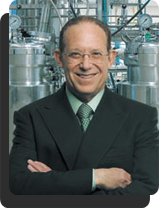The Human Genome Project was completed in 2003. An entire mapping out of what we are made of. But the project itself wasn't designed so that we could learn the coding of each gene in our bodies- the project was designed so that capable scientists like William Haseltine could take those sequences and use them to form treatments that would save lives. This is a section that carefully explains how Haseltine takes these life-changing technologies and applies them to their fullest potential.
The Human Genome Project was a worldwide effort to understand the all the genes in a human body, or genome. The Project's goals were to completely identify the approximate 25,000 genes in human DNA, sequence the 3 billion base pairs that make them up, and store this information in databases. The Project was completed in 2003, and has allowed us to see, for the first time, nature's genetic blueprint of a human being.
Started in 1990 by James D. Watson and funded by the Department of Energy (DOE) and the National Institute of Health (NIH), the Human Genome Project was originally supposed to take 15 years. Due to international cooperation and technological advances, a rough draft of the genome was released in 2000, and the project was complete in 2003. Not only was it completed two years ahead of schedule, but the accomplishments of HGP scientists surpassed their original goals. For instance, instead of sequencing only 95% of the human genome at 99.9% accuracy, they sequenced 99% at the same accuracy.
Decoding the human genome is the first step towards a revolution in healthcare. We now have the potential to locate the direct source of many diseases caused by genetic defects. Yet simply having the information is not enough; we must analyze the data and utilize it. Human Genome Sciences is the first and leading corporation to turn that data into drugs to help people around the world.
Return to Top --William Haseltine
--William Haseltine
What if you could live forever? For ages mankind has wondered about this possibility--in the legend of the Fountain of Youth, in the anti-aging creams, in the very fact that we are developing medicines to ultimately prevent death. Now, thanks to William Haseltine and his ideas, this possibility might become a reality.
Haseltine believes that a human can live forever, but it all depends on the cell. DNA has traveled from cell to cell for billions of years, being copied and split along with the cells that carry them. A theory of aging states that the cells in a body grow old, and fail to function. New, young cells, however, can replace old ones, constantly resetting the age of any living organism. According to Haseltine, DNA and cells can continue to divide and duplicate, allowing humans to live forever.
While we can't simply replace all our old cells with new ones, Haseltine and his company, Human Genome Sciences (HGSI) are working on an alternative. When the body produces less proteins than usual, it deteriorates. HGSI is working to make drugs that rebuild the body. These drugs are made from DNA in a test tube, pure human substance, and once taken they stimulate your body to produce proteins:
"The first and best choice will be to stimulate the body to regrow itself from the inside out. ... That's what a number of our drugs are designed to do. We place them in precise locations with new technologies, non-invasive technologies, and let them stimulate the body to regrow itself."
Haseltine calls this type of medicine "regenerative medicine" to describe the new revolution in curing diseases. He believes that soon we will have enough information to control the functions of every cell in the body.
Only one plan is not enough; Haseltine has an alternative, a back-up if taking drugs to rebuild tissues inside the body doesn't work. Genes will work to build tissues and organs outside the body, and will then be implanted:
"[O]ur next goal will be to regrow an organ from your own tissues outside the body for implantation. That's the second phase of regenerative medicine."
Haseltine's products seem to be working. HGSI has licensed a product to Vascular Genetics, Inc., who are working to create a "micro-vasculature [network of blood vessels] in heart muscle by direct injection of DNA into that muscle" (Haseltine). In preliminary experiments of 100 patients, the gene seemed to work well without any serious side effects. This one product has the potential to save millions from heart disesase; one can only imagine how many lives Haseltine and his company will save with his other products. This revolution in medicine, regenerative medicine, has not only the potential to cure disease, but the potential to allow humans eternal life.
"Death is not an intrinsic property of life. Life is intrinsically immortal. ... There is no reason why DNA cannot continue to convey the basis of life for another four billion years. Nothing about life necessitates death."-William Haseltine
Return to TopCell: Fundamental building units of every living system
Chromosome: Physically separate molecules that are sections of the human genome, ranging from 50 million to 250 million base pairs.
DNA: Deoxyribonucleic acid; contains genetic instructions to make proteins and carry out the basic functions of life
Gene: A specific sequence of nucleotides in DNA or RNA that is located usually on a chromosome and that is the functional unit of inheritance controlling the transmission and expression of one or more traits by specifying the structure of a particular polypeptide and especially a protein or controlling the function of other genetic material. Basic physical and functional units of heredity; specific sequences of bases that encode instructions on how to make proteins
Genome: All the genes in an organism
Human Genome Project: The worldwide effort to sequence and identify the entire human genome, started in 1990 and completed in 2003
Nucleotide: A small molecule that makes up nucleic acids, such as RNA and DNA; most are adenine (A), guanine (G), cytosine (C), and thymine (T) and urasil (U)
Protein: Large, complex molecules made up of smaller subunits called amino acids; perform most life functions and even make up the majority of cellular structures
Proteome: All the proteins in a cell
RNA: Ribonucleic acid; transcribed from DNA and translated into proteins
Return to Top



